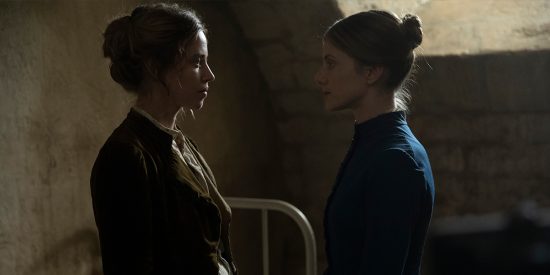TIFF 2021 Review: The Mad Women’s Ball – “Haunting and beautiful”

Image courtesy of TIFF
In 1885, Victor Hugo died. He was revered in France, and around the world for that matter, for his work. He was also a man who participated in many séances, communicating with the spirit world, mostly in an attempt to reach his deceased daughter. It is, therefore, no coincidence that Mélanie Laurent‘s newest film, The Mad Women’s Ball, opens with the protagonist, Eugénie (Lou de Laâge) sneaking out to attend his funeral. For she too sees spirits and converses with the dead.
Based on the novel by Victoria Mas, this film spins a dark and, at times, supernatural web. Laurent, who also adapted the screenplay alongside Chris Deslandes creates an atmospheric depiction of this development of ‘science’ which is little more than gaslighting, torture and in some circumstances, rape. Accompanied by a sorrowful score from Asaf Avidan, as well in many scenes by the sound of women’s screams, Lou de Laâge (star of Laurent’s 2014 TIFF film Breathe) is a formidable lead and saves intrigue, even when this film strays on the over-long. Laurent’s film is haunting and beautiful, at other times beyond disturbing, but is also in some moments a little heavy-handed, lacking subtleties that could have made it more impressive.
The Mad Women’s Ball is not an easy watch. Charcot, who is labelled as “the founder of modern neurology” is depicted using his patients, these women, as simply a means to an end, victims of a misogynistic paradigm that was part of societal understanding. If a woman in those days showed any display of strong emotion, she was ‘hysterical’ but even still those suffering from depression or those born with developmental issues could be institutionalized, completely against their will. Yet there are scenes in this film that celebrate the camaraderie of these ‘patients’ who helped each other more than this clinic ever could. The Mad Women’s Ball is a sombre tale, but also a testament to the strength and resilience of women.










